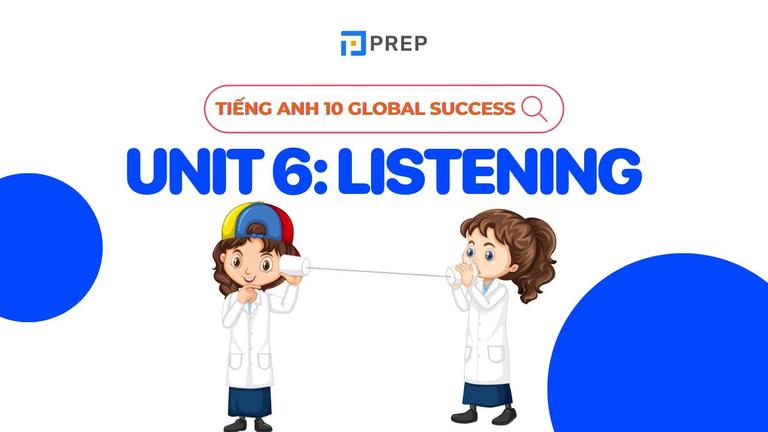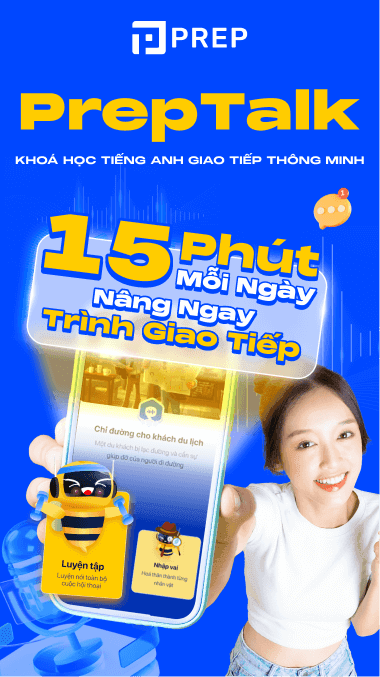Bài Đọc Tiếng Anh Lớp 6: 12 Bài Đọc Hiểu Có Đáp Án
Bài đọc tiếng Anh lớp 6 đóng vai trò quan trọng trong việc phát triển kỹ năng đọc hiểu và mở rộng vốn từ vựng cho học sinh. Bài viết này PREP cung cấp bộ sưu tập bài đọc tiếng Anh lớp 6 đa dạng chủ đề, từ cơ bản đến nâng cao, kèm đáp án chi tiết và phương pháp luyện tập hiệu quả giúp các em nâng cao kỹ năng đọc hiểu một cách toàn diện.
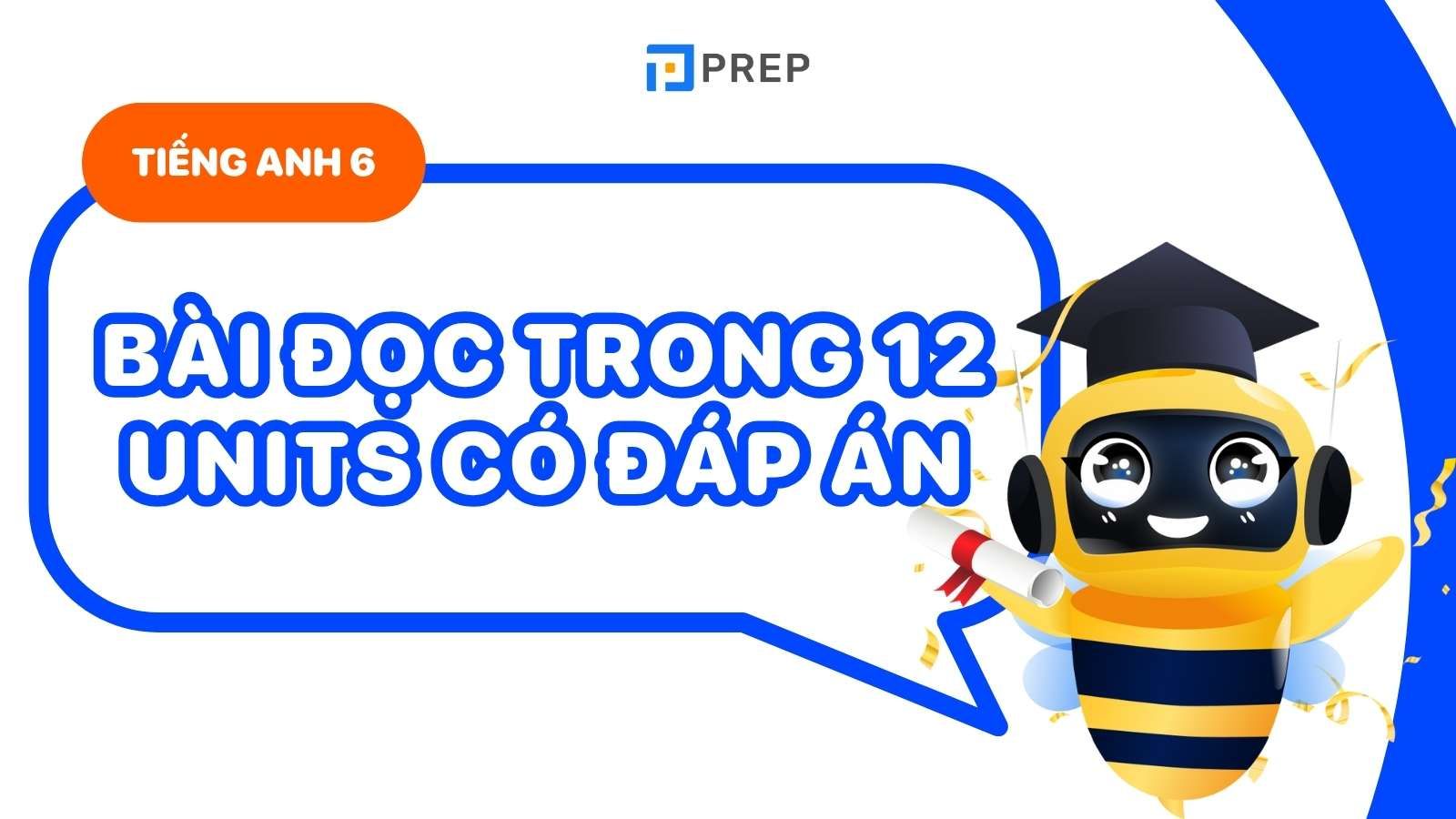
I. Tổng Quan Về Bài Đọc Tiếng Anh Lớp 6
1. Tầm Quan Trọng Của Kỹ Năng Đọc
Kỹ năng đọc hiểu tiếng Anh ở lớp 6 không chỉ giúp học sinh tiếp thu kiến thức mà còn phát triển tư duy logic và khả năng phân tích thông tin. Việc luyện tập thường xuyên với các bài đọc tiếng Anh lớp 6 sẽ giúp học sinh:
-
Phát triển vốn từ vựng: Mỗi bài đọc chứa đựng 15-25 từ vựng mới, giúp học sinh mở rộng kiến thức ngôn ngữ một cách tự nhiên.
-
Nâng cao khả năng hiểu ngữ cảnh: Thông qua việc đọc các đoạn văn có nội dung liên kết, học sinh học cách suy luận và đoán nghĩa từ mới.
-
Cải thiện tốc độ đọc: Từ 80-100 từ/phút ở đầu năm học, học sinh có thể đạt 120-150 từ/phút cuối năm.
2. Phân Loại Bài Đọc Theo Chủ Đề
Bài đọc theo 12 Units SGK Global Success:
-
Units 1-3: Chủ đề cá nhân (My New School, My House, My Friends)
-
Units 4-6: Chủ đề cộng đồng (My Neighbourhood, Natural Wonders, Our Tet Holiday)
-
Units 7-9: Chủ đề xã hội (Television, Sports and Games, Cities of the World)
-
Units 10-12: Chủ đề môi trường (Our Houses in the Future, Our Greener World, Robots)
II. Bài Đọc Tiếng Anh Lớp 6 12 Units Có Đáp Án
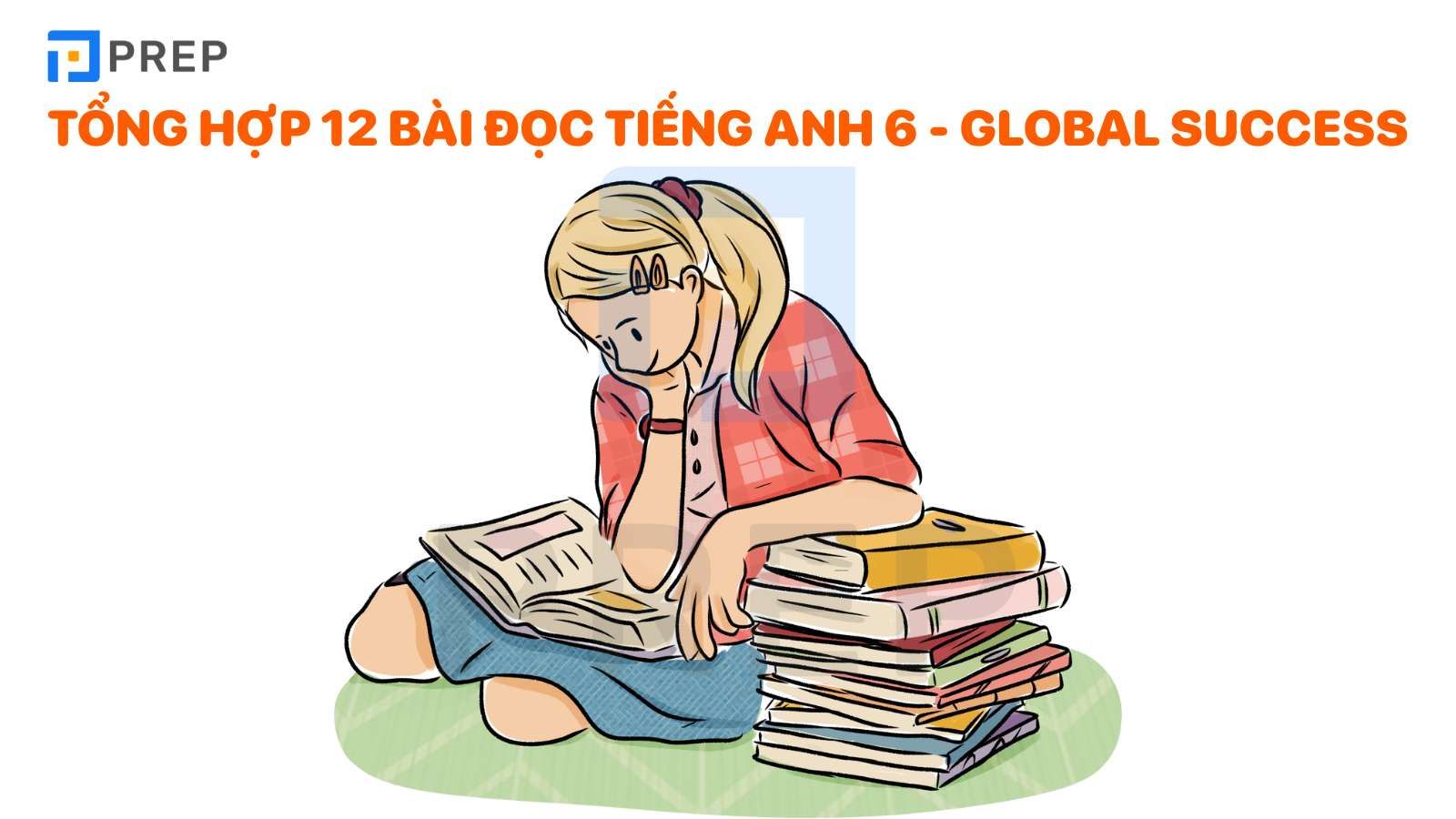
Bài đọc: "Greenwood International School"
My name is David and I'm excited to share about my new school - Greenwood International School. It's located in the heart of the city and has been serving students for over 20 years.
The school building is impressive with four floors and modern architecture. On the first floor, we have the main office, library, and cafeteria. The library contains more than 10,000 books in both English and Vietnamese, plus 50 computers for research. The cafeteria serves healthy meals and can accommodate 300 students at once.
The second and third floors house 30 bright classrooms equipped with smart boards and air conditioning. Each classroom can hold 25 students comfortably. The fourth floor features specialized rooms including two science laboratories, an art room, and a music room with various instruments.
What I love most about Greenwood is the outdoor area. We have a large playground with basketball and volleyball courts, plus a beautiful garden where students can relax during break time. The school also has a swimming pool that's used for PE classes and after-school activities.
The teachers here are highly qualified and caring. They use interactive teaching methods that make learning enjoyable. My class teacher, Mrs. Johnson, always encourages us to ask questions and express our opinions freely.
Vocabulary:
-
impressive (adj): ấn tượng
-
architecture (n): kiến trúc
-
accommodate (v): chứa được
-
equipped (adj): được trang bị
-
specialized (adj): chuyên biệt
-
qualified (adj): có trình độ
-
interactive (adj): tương tác
-
express (v): thể hiện
Questions:
-
How long has Greenwood International School been operating?
-
What can be found on the first floor?
-
How many students can each classroom hold?
-
What outdoor facilities does the school have?
Bài đọc: "My Cozy Home"
I live in a lovely two-story house in a quiet suburb with my parents and younger sister. Our house may not be the biggest, but it's filled with warmth and love.
When you enter through the front door, you'll see our spacious living room with comfortable sofas and a large TV. My family enjoys watching movies together here every weekend. The walls are decorated with family photos and my sister's artwork from school.
The ground floor also has a modern kitchen where my mom prepares delicious meals. It's equipped with all necessary appliances including a refrigerator, oven, and dishwasher. Next to the kitchen is a small dining room with a wooden table that seats six people.
Upstairs, there are three bedrooms and two bathrooms. My parents' room is the largest with a king-size bed and a walk-in closet. My sister and I each have our own room. My bedroom is painted blue - my favorite color - and has a desk where I do homework, a bookshelf full of novels, and a window overlooking our backyard garden.
The backyard is my favorite part of the house. My dad grows tomatoes, lettuce, and herbs in the vegetable garden. We also have a small patio where we barbecue during summer evenings. Our dog, Lucky, loves running around in the grass.
Vocabulary:
-
suburb (n): vùng ngoại ô
-
spacious (adj): rộng rãi
-
appliances (n): thiết bị gia dụng
-
walk-in closet (n): phòng thay đồ
-
overlooking (v): nhìn ra
-
herbs (n): rau thơm
-
patio (n): sân nhỏ
-
barbecue (v): nướng thịt ngoài trời
Questions:
-
Where is the house located?
-
What appliances can be found in the kitchen?
-
What color is the writer's bedroom?
-
What does the father grow in the garden?
Bài đọc: "My Best Friend Sarah"
I want to tell you about my best friend Sarah, whom I met on the first day of grade 6. She's not only a wonderful friend but also an inspiration to everyone around her.
Sarah is 12 years old, just like me, but she's quite tall for her age with long, curly brown hair and bright green eyes. What makes her special isn't her appearance, but her amazing personality. She's incredibly kind and always ready to help others. When our classmate Tom forgot his lunch money last week, Sarah immediately shared her sandwich with him without hesitation.
Sarah is also very talented. She plays the violin beautifully and often performs at school concerts. Her dream is to become a professional musician someday. Besides music, she excels in mathematics and often helps me with difficult problems. She explains things so clearly that even complex equations become easy to understand.
What I admire most about Sarah is her positive attitude. Even when things go wrong, she always finds something good to focus on. Last month, when it rained heavily during our school picnic, instead of complaining, she suggested we play indoor games and told funny stories that made everyone laugh.
We share many interests, including reading mystery novels, watching animated movies, and collecting postcards from different countries. Every Saturday, we visit the local library together and exchange book recommendations.
Vocabulary:
-
inspiration (n): nguồn cảm hứng
-
curly (adj): xoăn
-
personality (n): tính cách
-
hesitation (n): sự do dự
-
talented (adj): tài năng
-
professional (adj): chuyên nghiệp
-
excels (v): xuất sắc
-
equations (n): phương trình
-
positive attitude (n): thái độ tích cực
-
complaining (v): phàn nàn
-
animated (adj): hoạt hình
-
recommendations (n): gợi ý
Questions:
-
How old is Sarah?
-
What instrument does Sarah play?
-
What subjects is Sarah good at?
-
What do Sarah and the writer do every Saturday?
Bài đọc: "Life in Sunshine Neighbourhood"
I live in Sunshine Neighbourhood, a peaceful residential area that feels like a small community within the big city. What makes this place special is how everything we need is within walking distance.
Our neighbourhood has excellent facilities that serve residents' daily needs. The central shopping area includes a modern supermarket, a cozy bakery that sells fresh bread every morning, a pharmacy, and a bank. Mrs. Chen, who owns the corner bookstore, knows everyone by name and always recommends interesting books to young readers like me.
For recreation, we have a beautiful park in the center of the neighbourhood. The park features a children's playground with swings and slides, jogging paths surrounded by colorful flowers, and several benches where elderly people gather to chat and play chess. On weekends, families often have picnics on the green grass areas.
Transportation is very convenient here. The bus station is just five minutes away from my house, and buses run every 15 minutes to the city center. Many residents prefer cycling or walking because the streets are safe and well-maintained with proper sidewalks and street lighting.
The people in Sunshine Neighbourhood are incredibly friendly and helpful. During the recent flooding, neighbors worked together to help affected families. Mr. Johnson, who lives next door, often shares vegetables from his garden with everyone. This sense of community makes our neighbourhood feel like one big family.
Vocabulary:
-
residential (adj): thuộc khu dân cư
-
within walking distance: trong phạm vi đi bộ
-
facilities (n): tiện ích
-
residents (n): cư dân
-
cozy (adj): ấm cúng
-
recreation (n): giải trí
-
elderly (adj): người già
-
convenient (adj): thuận tiện
-
well-maintained (adj): được bảo trì tốt
-
sidewalks (n): vỉa hè
-
flooding (n): lũ lụt
-
sense of community (n): tinh thần cộng đồng
Questions:
-
What makes Sunshine Neighbourhood special?
-
Who owns the corner bookstore?
-
How often do buses run to the city center?
-
How did neighbors help during the recent flooding?
5. UNIT 5: NATURAL WONDERS OF VIET NAM
Bài đọc: "Phong Nha-Ke Bang National Park"
Phong Nha-Ke Bang National Park, located in Quang Binh Province, is one of Vietnam's most spectacular natural wonders and a UNESCO World Heritage Site since 2003. This remarkable park covers an area of 857.54 square kilometers and contains some of the world's most impressive cave systems.
The park is famous for its extraordinary underground world. Scientists have discovered over 2,500 caves here, including Son Tra Cave, which is considered the world's largest cave by volume. The caves were formed millions of years ago by underground rivers carving through limestone mountains. Inside these caves, visitors can admire stunning stalactites and stalagmites that create magical formations resembling castles, animals, and mythical creatures.
Above ground, the park features diverse ecosystems with dense tropical forests that are home to many rare species. The forest contains over 2,734 plant species and 381 animal species, including several endangered animals like the white-cheeked gibbon and the giant muntjac deer. The park's biodiversity makes it a paradise for nature lovers and researchers.
Adventure tourism is becoming increasingly popular in Phong Nha-Ke Bang. Brave tourists can explore underground rivers by boat, go cave trekking with professional guides, or try zip-lining through the forest canopy. The Dark Cave offers an exciting experience where visitors can swim in underground lakes and cover themselves with therapeutic mud.
The local community has greatly benefited from eco-tourism development. Many families now work as tour guides, boat operators, or run homestays for visitors. This sustainable tourism model helps preserve the natural environment while improving local people's livelihoods.
Vocabulary:
-
spectacular (adj): ngoạn mục
-
remarkable (adj): đáng chú ý
-
extraordinary (adj): phi thường
-
volume (n): thể tích
-
carving (v): khắc, tạo hình
-
stalactites (n): thạch nhũ
-
stalagmites (n): măng đá
-
formations (n): sự hình thành
-
mythical (adj): thần thoại
-
diverse ecosystems (n): hệ sinh thái đa dạng
-
endangered (adj): có nguy cơ tuyệt chủng
-
biodiversity (n): đa dạng sinh học
-
canopy (n): tán rừng
-
therapeutic (adj): có tác dụng chữa bệnh
-
sustainable (adj): bền vững
-
livelihoods (n): sinh kế
Questions:
-
When did Phong Nha-Ke Bang become a UNESCO World Heritage Site?
-
How many caves have scientists discovered in the park?
-
What makes Son Tra Cave special?
-
How has eco-tourism helped the local community?
Bài đọc: "Celebrating Tet in My Family"
Tet Nguyen Dan, or simply Tet, is the most important celebration in Vietnamese culture, marking the arrival of spring and the Lunar New Year. In my family, Tet preparation begins weeks before the actual holiday, creating an atmosphere of excitement and anticipation.
The preparation phase is almost as enjoyable as the celebration itself. My grandmother starts by cleaning our ancestral altar and preparing traditional offerings. Meanwhile, my mother and aunts shop for new clothes, decorative items, and special Tet foods. My father and uncles work together to paint the house and repair anything that needs fixing, following the tradition that everything should be perfect for the New Year.
Food preparation is a major part of Tet celebration. My family makes traditional dishes like banh chung (sticky rice cakes), gio lua (Vietnamese ham), and pickled vegetables. The process of making banh chung is particularly special - we gather around the kitchen, wrapping banana leaves around sticky rice, mung beans, and pork, then boiling them overnight. The delicious aroma fills the entire house.
On New Year's Eve, we stay up late to welcome the New Year with fireworks and family prayers. The first three days of Tet are dedicated to family reunions. Relatives travel from different provinces to gather at our ancestral home. Children receive lucky money in red envelopes called "li xi" from adults, symbolizing good fortune for the coming year.
During Tet, we also visit temples and pagodas to pray for health, happiness, and prosperity. The streets are decorated with colorful flowers, especially yellow mai flowers and pink peach blossoms, creating a festive atmosphere throughout the neighborhood.
Vocabulary:
-
Lunar New Year (n): Tết Âm lịch
-
anticipation (n): sự mong đợi
-
ancestral altar (n): bàn thờ tổ tiên
-
decorative (adj): trang trí
-
sticky rice cakes (n): bánh chưng
-
pickled vegetables (n): dưa muối
-
aroma (n): mùi thơm
-
reunions (n): đoàn tụ
-
provinces (n): tỉnh thành
-
symbolizing (v): tượng trưng
-
prosperity (n): thịnh vượng
-
pagodas (n): chùa
-
peach blossoms (n): hoa đào
-
festive atmosphere (n): không khí lễ hội
Questions:
-
When does Tet preparation begin in the writer's family?
-
What do the father and uncles do during preparation?
-
What are the main ingredients of banh chung?
-
What do yellow mai flowers and pink peach blossoms represent?
Bài đọc: "The Evolution of Television in My Household"
Television has played a significant role in my family's daily routine for as long as I can remember. Over the years, I've witnessed remarkable changes in how we consume television content and how it has shaped our family time.
When I was younger, we had an old CRT television with limited channels. My family would gather every evening to watch the 7 PM news together, followed by a family-friendly movie or variety show. Those were precious moments when we shared the same screen, discussed current events, and laughed together at comedic programs.
The transition to digital television brought us access to hundreds of channels with diverse content. Suddenly, we had dedicated channels for documentaries, cartoons, sports, cooking shows, and international news. My father became fascinated with history documentaries, while my mother enjoyed cooking programs that inspired her to try new recipes. My sister and I preferred animated series and educational shows about science and nature.
Today, our household has embraced smart TV technology and streaming services. We can now watch content on-demand, pause live television, and even access internet-based entertainment. Each family member has personalized viewing preferences, and we often watch different programs simultaneously on various devices - the main TV, tablets, or smartphones.
However, despite technological advances, we maintain the tradition of "Family Movie Night" every Friday. We take turns choosing a movie that everyone can enjoy, prepare popcorn and snacks, and spend quality time together. This tradition ensures that television remains a tool for family bonding rather than isolation.
Vocabulary:
-
significant (adj): quan trọng
-
witnessed (v): chứng kiến
-
consume (v): tiêu thụ
-
CRT television (n): TV màn hình ống
-
variety show (n): chương trình giải trí
-
comedic (adj): hài hước
-
transition (n): sự chuyển đổi
-
diverse (adj): đa dạng
-
dedicated (adj): chuyên biệt
-
documentaries (n): phim tài liệu
-
fascinated (adj): bị thu hút
-
streaming services (n): dịch vụ phát trực tuyến
-
on-demand (adj): theo yêu cầu
-
simultaneously (adv): đồng thời
-
advances (n): tiến bộ
-
bonding (n): gắn kết
-
isolation (n): sự cô lập
Questions:
-
What type of TV did the family have when the writer was younger?
-
What changes did digital television bring?
-
What does each family member prefer to watch?
-
How does the family maintain togetherness despite having different viewing preferences?
Bài đọc: "Sports Culture at Lincoln Middle School"
Sports and games play a vital role in student life at Lincoln Middle School, promoting physical fitness, teamwork, and healthy competition among students. Our school believes that athletic activities are just as important as academic subjects for developing well-rounded individuals.
The school offers an impressive variety of sports programs throughout the year. During the fall semester, students can participate in soccer, volleyball, and cross-country running. Soccer is particularly popular, with both boys' and girls' teams competing in the regional championship. Our soccer teams have won multiple trophies over the past five years, thanks to dedicated coaching and student commitment.
Winter brings basketball and swimming seasons. The basketball teams practice rigorously three times a week in our modern gymnasium. Swimming lessons take place in the school's Olympic-size pool, where students learn different strokes and water safety techniques. Many students who initially feared water have become confident swimmers through these programs.
Spring semester features tennis, baseball, and track and field events. The annual Sports Day in May is the highlight of the school year, where students compete in various individual and team events. Parents and community members attend this exciting event, creating an atmosphere of school pride and community support.
Beyond competitive sports, the school also emphasizes recreational activities and traditional games. During lunch breaks, students enjoy playing badminton, table tennis, or traditional Vietnamese games like "O an quan" and "Jumping rope." These activities help students relax and socialize with peers from different grade levels.
The positive impact of sports on students is clearly visible. Participants develop leadership skills, learn to handle both victory and defeat gracefully, and form lasting friendships with teammates. Academic performance often improves as students learn time management and discipline through sports participation.
Vocabulary:
-
vital (adj): thiết yếu
-
athletic (adj): thuộc thể thao
-
well-rounded (adj): toàn diện
-
impressive (adj): ấn tượng
-
participate (v): tham gia
-
cross-country running (n): chạy việt dã
-
championship (n): giải vô địch
-
trophies (n): cúp, giải thưởng
-
dedication (n): sự cống hiến
-
commitment (n): cam kết
-
rigorously (adv): nghiêm khắc
-
gymnasium (n): phòng tập thể dục
-
strokes (n): kiểu bơi
-
recreational (adj): giải trí
-
emphasizes (v): nhấn mạnh
-
gracefully (adv): một cách thanh lịch
-
lasting (adj): lâu dài
-
discipline (n): kỷ luật
Questions:
-
What sports are offered during the fall semester?
-
How often do basketball teams practice?
-
What happens during the annual Sports Day?
-
How do sports activities benefit students academically?
9. UNIT 9: CITIES OF THE WORLD
Bài đọc: "Singapore: The Garden City"
Singapore, often called the "Garden City," is a fascinating island nation that has transformed itself from a small trading port into one of the world's most modern and livable cities. This remarkable city-state successfully combines urban development with environmental conservation.
Located at the southern tip of the Malay Peninsula, Singapore covers only 719 square kilometers but houses over 5.8 million people. Despite its small size and high population density, the city maintains an impressive amount of green space. Nearly 50% of Singapore is covered by vegetation, including parks, gardens, and nature reserves that provide clean air and recreational opportunities for residents.
The city's architecture perfectly blends tradition with innovation. Modern skyscrapers stand alongside heritage buildings from the colonial era. The iconic Marina Bay Sands hotel, with its distinctive rooftop infinity pool, has become a symbol of Singapore's futuristic vision. Meanwhile, historic neighborhoods like Chinatown and Little India preserve the cultural heritage of Singapore's diverse population.
Singapore's efficient public transportation system is world-renowned. The Mass Rapid Transit (MRT) network connects every corner of the island with clean, punctual, and affordable trains. Most residents rely on public transport rather than private cars, which helps reduce traffic congestion and air pollution.
The city's commitment to sustainability is evident everywhere. Singapore has implemented innovative water management systems, including water recycling and desalination plants that ensure water security. The government promotes green building practices, and many new constructions feature vertical gardens and solar panels.
Education and multiculturalism are highly valued in Singapore. The country has four official languages: English, Mandarin, Malay, and Tamil, reflecting its diverse heritage. This linguistic diversity, combined with excellent educational institutions, has made Singapore a global hub for business and innovation.
Vocabulary:
-
fascinating (adj): hấp dẫn
-
transformed (v): biến đổi
-
trading port (n): cảng thương mại
-
livable (adj): đáng sống
-
conservation (n): bảo tồn
-
peninsula (n): bán đảo
-
population density (n): mật độ dân số
-
vegetation (n): thảm thực vật
-
innovation (n): đổi mới
-
skyscrapers (n): tòa nhà chọc trời
-
heritage buildings (n): các tòa nhà di sản
-
colonial era (n): thời kỳ thuộc địa
-
distinctive (adj): đặc biệt
-
infinity pool (n): hồ bơi vô cực
-
futuristic (adj): tương lai
-
punctual (adj): đúng giờ
-
congestion (n): tắc nghẽn
-
sustainability (n): tính bền vững
-
desalination (n): khử muối
-
multiculturalism (n): đa văn hóa
-
linguistic (adj): thuộc ngôn ngữ
Questions:
-
What percentage of Singapore is covered by vegetation?
-
What makes Marina Bay Sands hotel iconic?
-
How does Singapore's transportation system help the environment?
-
What are Singapore's four official languages?
10. UNIT 10: OUR HOUSES IN THE FUTURE
Bài đọc: "Smart Homes of Tomorrow"
Imagine waking up in a house that anticipates your every need, adjusts the temperature automatically, and helps you live more sustainably. This isn't science fiction anymore - it's the reality of smart homes that are becoming increasingly common and affordable.
Future homes will be equipped with artificial intelligence systems that learn from residents' daily routines and preferences. Your house will know when you typically wake up and gradually brighten the bedroom lights while starting your coffee maker. The bathroom mirror will display your daily schedule, weather forecast, and health reminders while you brush your teeth.
Energy efficiency will be a cornerstone of future housing. Solar panels integrated into roof tiles will generate clean electricity, while smart batteries store excess energy for use during cloudy days or nighttime. Advanced insulation materials will maintain comfortable temperatures year-round while minimizing energy consumption. Smart thermostats will automatically adjust heating and cooling based on occupancy and external weather conditions.
Home security will reach new levels of sophistication. Facial recognition cameras will grant access to family members while alerting homeowners about unfamiliar visitors. Smart doorbells with two-way video communication will allow residents to interact with delivery personnel even when away from home. Motion sensors throughout the house will detect unusual activity and immediately notify security services.
The kitchen of the future will revolutionize meal preparation. Smart refrigerators will monitor food inventory, suggest recipes based on available ingredients, and automatically order groceries when supplies run low. Robotic assistants will help with cooking tasks, while dishwashers will start cleaning cycles during off-peak electricity hours to reduce energy costs.
However, these technological advances also present challenges. Privacy concerns arise as smart devices collect personal data about residents' habits and preferences. Additionally, the initial cost of implementing smart home technology remains high, though prices are gradually decreasing as the technology becomes more widespread.
Vocabulary:
-
anticipates (v): dự đoán trước
-
sustainably (adv): bền vững
-
artificial intelligence (n): trí tuệ nhân tạo
-
routines (n): thói quen
-
gradually (adv): từ từ
-
forecast (n): dự báo
-
cornerstone (n): nền tảng
-
integrated (adj): tích hợp
-
excess (adj): dư thừa
-
insulation (n): cách nhiệt
-
occupancy (n): sự có mặt
-
sophistication (n): sự tinh vi
-
facial recognition (n): nhận dạng khuôn mặt
-
unfamiliar (adj): không quen thuộc
-
personnel (n): nhân viên
-
revolutionize (v): cách mạng hóa
-
inventory (n): hàng tồn kho
-
off-peak (adj): giờ thấp điểm
-
implementing (v): thực hiện
-
widespread (adj): phổ biến
Questions:
-
How will AI systems in future homes learn about residents?
-
What role will solar panels play in future homes?
-
How will smart refrigerators help with meal preparation?
-
What challenges do smart homes present?
11. UNIT 11: OUR GREENER WORLD
Bài đọc: "Green Schools Initiative"
The Green Schools Initiative represents a growing movement to transform educational institutions into environmentally responsible spaces that teach sustainability through daily practice. Schools worldwide are implementing innovative programs that reduce environmental impact while educating students about ecological responsibility.
Riverside Elementary School exemplifies this green transformation. Three years ago, the school launched an ambitious sustainability program that has dramatically changed how students, teachers, and the community think about environmental stewardship. The results have exceeded everyone's expectations.
The school's energy conservation efforts focus on renewable sources and efficient usage. Solar panels installed on the roof generate 70% of the school's electricity needs, while motion-sensor LED lights automatically turn off in empty classrooms. Students monitor energy consumption through digital displays in hallways, creating awareness about daily usage patterns. The school has reduced its electricity bills by 45% since implementing these measures.
Water conservation plays an equally important role in the green initiative. Rainwater harvesting systems collect precipitation from rooftops and channel it to underground storage tanks. This collected water irrigates the school's organic garden and supplies water for cleaning purposes. Low-flow faucets and dual-flush toilets throughout the building minimize water waste.
The organic garden has become the heart of the environmental education program. Students of all grades participate in planting, maintaining, and harvesting vegetables, herbs, and fruits. The produce supplies the school cafeteria with fresh, chemical-free ingredients for meals. This hands-on experience teaches students about sustainable agriculture, nutrition, and the connection between food choices and environmental health.
Waste reduction strategies include comprehensive recycling programs and composting systems. Students sort waste into different categories: recyclables, compostable organic matter, and minimal landfill waste. The composting program transforms food scraps and garden waste into nutrient-rich soil amendments for the school garden.
Vocabulary:
-
initiative (n): sáng kiến
-
environmentally responsible (adj): có trách nhiệm với môi trường
-
implementing (v): thực hiện
-
ecological (adj): thuộc sinh thái
-
exemplifies (v): minh họa
-
ambitious (adj): tham vọng
-
stewardship (n): việc quản lý bảo vệ
-
exceeded (v): vượt quá
-
renewable (adj): tái tạo
-
consumption (n): sự tiêu thụ
-
harvesting (v): thu hoạch
-
precipitation (n): lượng mưa
-
irrigates (v): tưới tiêu
-
dual-flush (adj): xả đôi
-
comprehensive (adj): toàn diện
-
composting (n): ủ phân hữu cơ
-
compostable (adj): có thể ủ phân
-
amendments (n): chất cải tạo đất
Questions:
-
How much of the school's electricity is generated by solar panels?
-
What is the purpose of rainwater harvesting systems?
-
How does the organic garden contribute to the cafeteria?
-
What are the three categories for waste sorting?
12. UNIT 12: ROBOTS
Bài đọc: "Robots in Modern Healthcare"
The integration of robots into healthcare systems represents one of the most promising applications of modern technology. Medical robots are revolutionizing patient care, surgical procedures, and hospital operations, offering unprecedented precision and capabilities that supplement human expertise.
Surgical robots have transformed operating rooms worldwide. The da Vinci Surgical System, for example, allows surgeons to perform minimally invasive procedures with enhanced precision and control. These robots translate the surgeon's hand movements into smaller, more precise movements of tiny instruments inside the patient's body. The 3D high-definition vision system provides surgeons with a magnified view of the surgical site, enabling procedures that would be impossible with traditional methods.
In patient care, companion robots are addressing the growing challenge of elderly care and patient loneliness. PARO, a therapeutic robot resembling a baby seal, provides emotional support to patients with dementia and autism. These robots respond to touch, voice, and light, adapting their behavior to individual patients' needs. Studies show that interaction with therapeutic robots can reduce stress, improve mood, and increase social engagement among elderly patients.
Rehabilitation robots assist patients recovering from strokes, spinal injuries, and other conditions that affect mobility. These sophisticated machines guide patients through repetitive exercises, adjusting difficulty levels based on individual progress. The robots provide consistent therapy sessions and detailed progress tracking that helps medical professionals optimize treatment plans.
Pharmacy robots ensure medication accuracy and efficiency in hospitals. These automated systems store, dispense, and track thousands of medications, reducing human errors that could have serious consequences. The robots can prepare personalized medication packages for individual patients, complete with detailed labeling and dosage instructions.
Despite these remarkable advances, the integration of robots in healthcare faces several challenges. High implementation costs limit access for smaller healthcare facilities. Additionally, medical professionals require extensive training to operate complex robotic systems effectively. Privacy and security concerns also arise as robots collect and store sensitive patient data.
Vocabulary:
-
integration (n): sự tích hợp
-
unprecedented (adj): chưa từng có
-
supplement (v): bổ sung
-
expertise (n): chuyên môn
-
minimally invasive (adj): xâm lấn tối thiểu
-
enhanced (adj): được cải thiện
-
translate (v): chuyển đổi
-
magnified (adj): được phóng to
-
therapeutic (adj): điều trị
-
dementia (n): chứng mất trí
-
autism (n): tự kỷ
-
rehabilitation (n): phục hồi chức năng
-
strokes (n): đột quỵ
-
spinal injuries (n): chấn thương cột sống
-
mobility (n): khả năng di chuyển
-
sophisticated (adj): tinh vi
-
repetitive (adj): lặp đi lặp lại
-
dispense (v): phân phát
-
dosage (n): liều lượng
-
implementation (n): việc thực hiện
-
extensive (adj): sâu rộng
-
sensitive (adj): nhạy cảm
Questions:
-
How do surgical robots enhance precision during operations?
-
What type of patients benefit from therapeutic robots like PARO?
-
How do rehabilitation robots help patients recover?
-
What challenges face the integration of robots in healthcare?
13. Đáp án
UNIT 1: MY NEW SCHOOL
-
Over 20 years
-
Main office, library, and cafeteria
-
25 students
-
Basketball courts, volleyball courts, swimming pool, and garden
UNIT 2: MY HOUSE
-
In a quiet suburb
-
Refrigerator, oven, and dishwasher
-
Blue
-
Tomatoes, lettuce, and herbs
UNIT 3: MY FRIENDS
-
12 years old
-
Violin
-
Mathematics
-
Visit the local library and exchange book recommendations
UNIT 4: MY NEIGHBOURHOOD
-
Everything needed is within walking distance
-
Mrs. Chen
-
Every 15 minutes
-
Neighbors worked together to help affected families
UNIT 5: NATURAL WONDERS OF VIET NAM
-
2003
-
Over 2,500 caves
-
It's the world's largest cave by volume
-
Many families work as tour guides, boat operators, or run homestays
UNIT 6: OUR TET HOLIDAY
-
Weeks before the actual holiday
-
Paint the house and repair anything that needs fixing
-
Sticky rice, mung beans, and pork
-
They create a festive atmosphere throughout the neighborhood
UNIT 7: TELEVISION
-
An old CRT television with limited channels
-
Access to hundreds of channels with diverse content
-
Father: history documentaries; Mother: cooking programs; Kids: animated series and educational shows
-
By maintaining "Family Movie Night" every Friday
UNIT 8: SPORTS AND GAMES
-
Soccer, volleyball, and cross-country running
-
Three times a week
-
Students compete in various individual and team events with parents attending
-
Students learn time management and discipline
UNIT 9: CITIES OF THE WORLD
-
Nearly 50%
-
Its distinctive rooftop infinity pool
-
Reduces traffic congestion and air pollution
-
English, Mandarin, Malay, and Tamil
UNIT 10: OUR HOUSES IN THE FUTURE
-
By learning from residents' daily routines and preferences
-
Generate clean electricity and store excess energy
-
Monitor food inventory, suggest recipes, and automatically order groceries
-
Privacy concerns and high initial costs
UNIT 11: OUR GREENER WORLD
-
70%
-
To collect rainwater for irrigation and cleaning purposes
-
Supplies fresh, chemical-free ingredients for meals
-
Recyclables, compostable organic matter, and minimal landfill waste
UNIT 12: ROBOTS
-
By translating surgeon's movements into smaller, more precise movements with 3D vision
-
Patients with dementia and autism
-
Guide patients through repetitive exercises and adjust difficulty based on progress
-
High costs, training requirements, and privacy concerns
III. Phương Pháp Làm Bài Đọc Hiểu Hiệu Quả
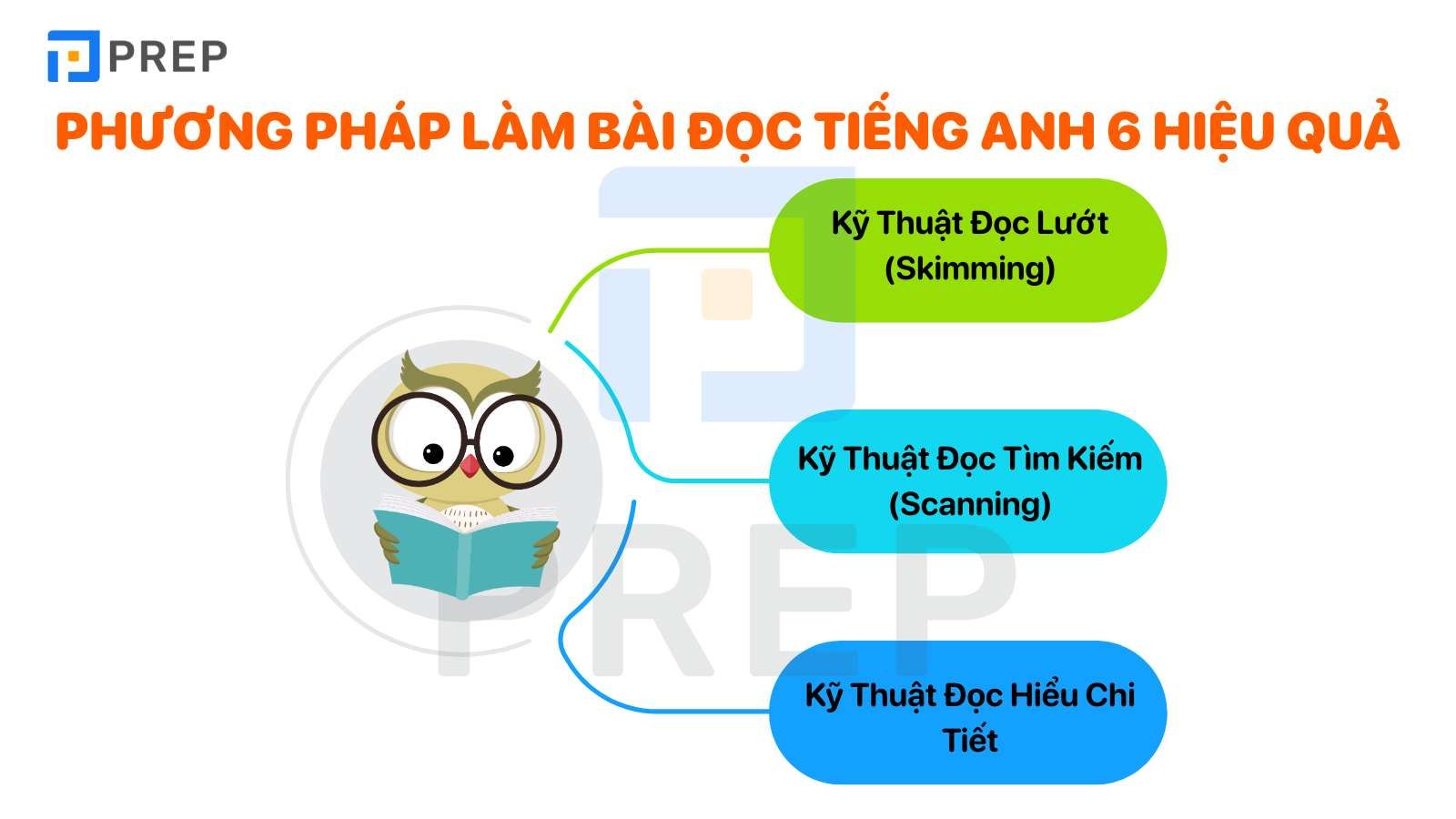
1. Kỹ Thuật Đọc Lướt (Skimming)
Mục đích: Nắm bắt ý chính của bài đọc trong thời gian ngắn
Cách thực hiện:
-
Đọc tiêu đề và câu đầu tiên của mỗi đoạn
-
Chú ý đến từ khóa và cụm từ quan trọng
-
Bỏ qua chi tiết không cần thiết
-
Thời gian thực hiện: 1-2 phút cho bài đọc 150 từ
Ví dụ thực hành: Với bài đọc về Ha Long Bay ở trên, khi đọc lướt, học sinh sẽ nhanh chóng nhận ra:
-
Chủ đề chính: Ha Long Bay - natural wonder
-
Vị trí: Quang Ninh Province
-
Đặc điểm: UNESCO World Heritage Site
-
Hoạt động: boat cruises, explore caves
2. Kỹ Thuật Đọc Tìm Kiếm (Scanning)
Mục đích: Tìm thông tin cụ thể để trả lời câu hỏi
Cách thực hiện:
-
Đọc câu hỏi trước khi đọc bài
-
Xác định từ khóa trong câu hỏi
-
Quét nhanh bài đọc để tìm từ khóa tương ứng
-
Đọc kỹ phần chứa thông tin cần tìm
Bảng từ khóa thường gặp:
|
Loại câu hỏi |
Từ khóa signal |
Ví dụ |
|
Thời gian |
when, time, period |
When is the best time...? |
|
Địa điểm |
where, location, place |
Where is Ha Long Bay...? |
|
Số lượng |
how many, number |
How many floors...? |
|
Lý do |
why, because, reason |
Why does Emma like...? |
|
Cách thức |
how, method, way |
How does Emma feel...? |
3. Kỹ Thuật Đọc Hiểu Chi Tiết
Bước 1: Đọc toàn bộ bài một cách chậm rãi
-
Tập trung vào nghĩa của từng câu
-
Ghi chú những từ không biết
-
Hiểu mối liên hệ giữa các câu
Bước 2: Phân tích cấu trúc bài đọc
-
Xác định câu chủ đề của mỗi đoạn
-
Tìm hiểu cách tác giả phát triển ý tưởng
-
Nhận biết các từ nối logic
Bước 3: Trả lời câu hỏi có căn cứ
-
Dẫn chứng cụ thể từ bài đọc
-
Không thêm thông tin ngoài bài đọc
-
Kiểm tra lại đáp án với nguyên văn
Bài đọc tiếng Anh lớp 6 đóng vai trò nền tảng trong việc phát triển kỹ năng ngôn ngữ toàn diện cho học sinh bậc trung học cơ sở. Thông qua bộ sưu tập 12 bài đọc theo chủ đề SGK Global Success, học sinh không chỉ củng cố kiến thức từ vựng và ngữ pháp mà còn mở rộng hiểu biết về thế giới xung quanh.
PREP mang đến phương pháp học tiếng Anh online thông minh cùng AI độc quyền. Bạn sẽ được học trực tuyến tại nhà, tự học hiệu quả và chuẩn bị cho các kỳ thi như IELTS, TOEIC, VSTEP, APTIS, hay nâng cao kỹ năng giao tiếp. Sự hỗ trợ từ Teacher Bee AI giúp bạn giải quyết mọi vấn đề, học tập dễ dàng và nhanh chóng.
Liên hệ HOTLINE 0931428899 hoặc nhấn TẠI ĐÂY để đăng ký khóa học!
Tải app PREP ngay để học tiếng Anh trực tuyến chất lượng tại nhà.
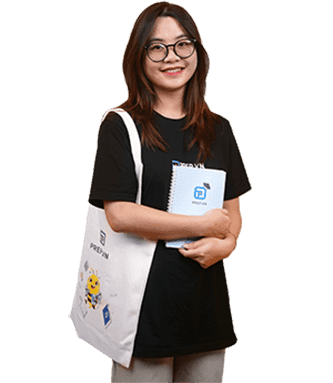
Chào bạn! Mình là Hiền Hoàng, hiện đang đảm nhận vai trò quản trị nội dung sản phẩm tại Blog của website prepedu.com.
Với hơn 5 năm tự học các ngoại ngữ như tiếng Anh, tiếng Trung và ôn luyện một số kỳ thi IELTS, TOEIC, HSK, mình đã tự đúc rút được nhiều kinh nghiệm để hỗ trợ hàng nghìn người đang gặp khó khăn trong việc học ngoại ngữ. Hy vọng rằng những chia sẻ phía trên sẽ giúp ích cho bạn trong quá trình tự ôn luyện thi hiệu quả tại nhà!
Bình luận
Nội dung premium
Xem tất cảLộ trình cá nhân hoá
Có thể bạn quan tâm
Kết nối với Prep
MSDN: 0109817671.
Địa chỉ liên hệ: Tòa nhà Vinaconex, 34 Láng Hạ, phường Láng, TP Hà Nội.
Địa chỉ kinh doanh: Lô 21 C2 Khu đô thị Nam Trung Yên, phường Yên Hòa, TP Hà Nội.
Trụ sở: Số nhà 20, ngách 234/35 đường Hoàng Quốc Việt, phường Nghĩa Đô, TP Hà Nội.
Phòng luyện ảo - Trải nghiệm thực tế - Công nghệ hàng đầu.
Hotline: 0931 42 8899.
Trụ sở: Số nhà 20, ngách 234/35 đường Hoàng Quốc Việt, phường Nghĩa Đô, TP Hà Nội.
Giấy chứng nhận hoạt động đào tạo, bồi dưỡng số 1309/QĐ-SGDĐT ngày 31 tháng 07 năm 2023 do Sở Giáo dục và Đào tạo Hà Nội cấp.
